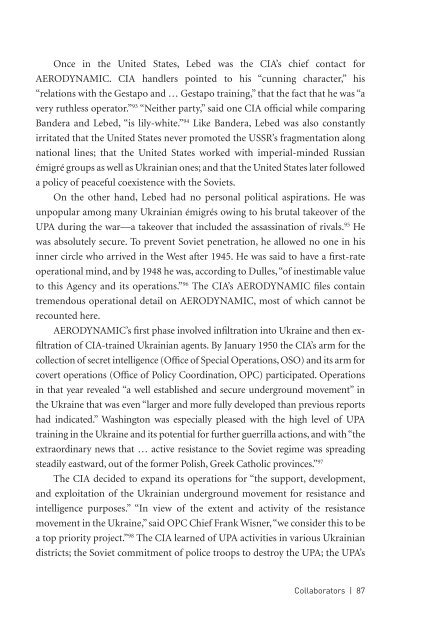hitlers-shadow
hitlers-shadow
hitlers-shadow
Create successful ePaper yourself
Turn your PDF publications into a flip-book with our unique Google optimized e-Paper software.
Once in the United States, Lebed was the CIA’s chief contact for<br />
AERODYNAMIC. CIA handlers pointed to his “cunning character,” his<br />
“relations with the Gestapo and … Gestapo training,” that the fact that he was “a<br />
very ruthless operator.” 93 “Neither party,” said one CIA official while comparing<br />
Bandera and Lebed, “is lily-white.” 94 Like Bandera, Lebed was also constantly<br />
irritated that the United States never promoted the USSR’s fragmentation along<br />
national lines; that the United States worked with imperial-minded Russian<br />
émigré groups as well as Ukrainian ones; and that the United States later followed<br />
a policy of peaceful coexistence with the Soviets.<br />
On the other hand, Lebed had no personal political aspirations. He was<br />
unpopular among many Ukrainian émigrés owing to his brutal takeover of the<br />
UPA during the war––a takeover that included the assassination of rivals. 95 He<br />
was absolutely secure. To prevent Soviet penetration, he allowed no one in his<br />
inner circle who arrived in the West after 1945. He was said to have a first-rate<br />
operational mind, and by 1948 he was, according to Dulles, “of inestimable value<br />
to this Agency and its operations.” 96 The CIA’s AERODYNAMIC files contain<br />
tremendous operational detail on AERODYNAMIC, most of which cannot be<br />
recounted here.<br />
AERODYNAMIC’s first phase involved infiltration into Ukraine and then exfiltration<br />
of CIA-trained Ukrainian agents. By January 1950 the CIA’s arm for the<br />
collection of secret intelligence (Office of Special Operations, OSO) and its arm for<br />
covert operations (Office of Policy Coordination, OPC) participated. Operations<br />
in that year revealed “a well established and secure underground movement” in<br />
the Ukraine that was even “larger and more fully developed than previous reports<br />
had indicated.” Washington was especially pleased with the high level of UPA<br />
training in the Ukraine and its potential for further guerrilla actions, and with “the<br />
extraordinary news that … active resistance to the Soviet regime was spreading<br />
steadily eastward, out of the former Polish, Greek Catholic provinces.” 97<br />
The CIA decided to expand its operations for “the support, development,<br />
and exploitation of the Ukrainian underground movement for resistance and<br />
intelligence purposes.” “In view of the extent and activity of the resistance<br />
movement in the Ukraine,” said OPC Chief Frank Wisner, “we consider this to be<br />
a top priority project.” 98 The CIA learned of UPA activities in various Ukrainian<br />
districts; the Soviet commitment of police troops to destroy the UPA; the UPA’s<br />
Collaborators | 87


